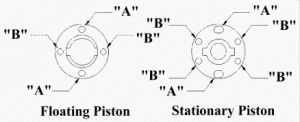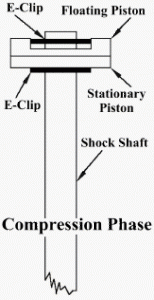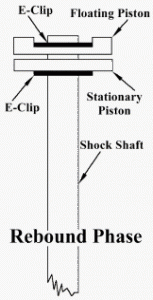Caution: RPM Shock Pistons are for advanced suspension tech’s only! It is imperative that you know how to “read” what your vehicle is doing to make necessary suspension adjustments. If you are not extremely comfortable with suspension set-up’s and how changes in the suspension affect handling, please do not attempt to install RPM Two Stage Shock Pistons.
A: RPM two stage shock pistons work better than any other R/C shock piston because they allow the shock to return to its static ride height at a much faster rate than do stock pistons. Our shock pistons act as miniature check valves (one way valves) that work instantaneously as the direction of the flow of oil through the piston changes. Consider all of the things that cause a shock to compress versus what causes it to rebound. The following is a short list of some of those factors;
The speed of the vehicle.
The size of the jump or bumps.
The weight of the vehicle.
Driver’s skill level.
With all shocks, including piggy-back type shocks and externally adjustable shocks**, the shock spring is the only thing that returns the shock to normal, static height. Up until the invention of the RPM Two Stage Shock Pistons, suspension set-up has always been a compromise. If you set-up the vehicle for the big jumps, it usually wouldn’t handle as well over the small stuff (suspension too stiff & bouncy). Likewise, if you set-up your vehicle for the smaller stuff, the vehicle would usually bottom out over the jumps (suspension too soft). This is because all other shock pistons have the same dampening (resistance) on both the compression stroke as well as the rebound stroke.
With RPM Two Stage Shock Pistons, the compromise no longer exists! Our pistons allow normal dampening during the compression of the shock and increased oil flow on the rebound stroke for a quicker recovery with a normal, soft spring. This allows the suspension to stay planted and not over-compress or bounce.

Top View of Stationary & Floating Pistons
RPM shock pistons consist of a pair of pistons for each shock; a floating piston, and a stationary piston. As you can see by the above illustration, once the pair is keyed together on the shock shaft, only the holes marked “A” will line up. The holes marked “B” are the check valve holes (one way valves).
Under compression, the check valve holes close against the opposing piston and only allow fluid to pass through the metered holes “A” (the metered holes are the holes that determine the compression rate of the piston). As soon as the shock shaft changes direction (rebound), the floating piston moves away from the stationary piston and allows fluid to pass through all four holes in the floating piston (the two primary metering holes “A” as well as the two bypass holes “B”). Because the piston is now using four holes instead of two, the shock is allowed to return back to static height much quicker.Rebound Phase
So, what does this all mean? It means that with RPM Two Stage Shock Pistons, you can tune your suspension to the most difficult section of the track without having to worry about how it will affect the handling characteristics of your vehicle in other sections because the rebound rate of the shock will be able to recover much quicker than with a stock piston.
** Externally dampened shock shafts (EDC) will not work with RPM Two Stage Shock Pistons. Our 1/10th scale pistons require a 1/8″ dia. shock shaft and cannot be externally adjusted.
Recommendations:
Most Vehicles: Regardless of piston choice, 30 – 40wt. oil is the best starting point. A variation in excess of 10wt. either up or down should be met with a piston change (next lighter dampening piston at 20wt. or next heavier dampening piston at 50wt.) to return your settings back to the 30 – 40wt. range.
#80420 – Use only with short A-arm, lightweight vehicles such as buggies or if your application requires very light suspension dampening.
#80430 – More general use. Long A-arm buggies, 1/10th scale stadium trucks, monster trucks, & sedans.
Suggestions
Most 2wd & 4×4 1/10th scale trucks:
Start with stock springs and 40wt. oil in both the front and rear shocks. Using the RPM #80430 kit, replace the stock pistons in the front shocks with RPM green pistons and RPM Purple pistons in the rear shocks. This is an excellent choice for most racers and bashers although we highly recommend fine tuning the spring preload, oil weights and piston choices to match your driving style and conditions where you drive.
T-Maxx & E-Maxx:
Use stock springs for most trucks unless heavily modified with aluminum parts, then a slightly heavier spring may be necessary as well as different weight oils may be needed from what is listed below. As a rule, please start with the set-ups listed below using stock springs.
Best Piston set-up: RPM Purple pistons from the #80430 – medium to heavy set – in all eight shocks (which requires a second package of RPM #80430 Pistons) with 30wt. oil in the front shocks & 40wt. oil in the rear shocks.
Alternate set-up: (Uses one package of #80430 Pistons) RPM Purple pistons in the rear four shocks and RPM Green pistons in the front four shocks with 40wt. oil in all eight shocks.


